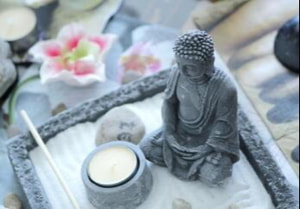 By Daniel Weidner The Buddha, the Dharma, and the Sangha are the three foundational legs of the Buddhist tripod. The Buddha was the original teacher, the Dharma consists of the teachings of the Buddha (and his followers), and the Sangha is the spiritual community that connects those who study and practice the Dharma -- as taught by the Buddha and his followers over the last 2,500 years. These are often referred to as “the three jewels” of Buddhist Mindfulness practice. I began to study the Dharma in the early seventies. Americans at that time who wanted to learn the Dharma had to travel to India, Tibet, Thailand, and other countries in the East if they wanted to participate in any in-depth teachings and practices emanating from the Dharma. Sanghas were few and far between in the United States. At that time there was no internet and there were very few books or journals (published in English) available for learning the Dharma. However, it was at this time that the teachings of the Buddha were increasingly beginning to appear in western culture, and the Dharma began to become sporadically available. Sanghas, or communities of mindfulness practitioners, were slowly beginning to develop in the West. These communities first began to appear in California, Colorado, Oregon, and some places on the East Coast. Individuals who were living in other parts of the country, including the Midwest, (e.g., Omaha) had to travel long distances to connect with others who were learning and practicing Mindfulness. As a young college student, living in Omaha in the early seventies, I felt somewhat alone as a student of Mindfulness, and there were no sanghas where I could join with, and learn from others. The Sangha is not considered to be an optional part of the practice of Mindfulness. It is understood to be essential to learning and practicing the life lessons that were taught by the Buddha. The teachings of Mindfulness can sometimes feel esoteric and somewhat abstract or difficult to translate for those living in Western culture. The Sangha is where students of the Dharma can come together to learn about and share in the teachings, and to develop the practices that facilitate one’s ability to live in a mindful and conscious manner. It is the place where the teachings can become less abstract and become functionally operational. The Buddha taught that good friendship, good companionship, and good comradeship are essential to one’s ability to learn and assimilate the teachings of Mindfulness into one’s life. The Buddha taught that the Sangha is the path - that spiritual friendship is the path. Sanghas can take many forms and are subject to the variations and vicissitudes of most human endeavors. The sangha has sometimes been referred to as a quilt that is woven together through the teachings of the Buddha and the spiritual friendships that develop among the members of the Sangha. But the Sangha is not just a “club” or social vehicle. It is a place where students who want to develop their understanding and practice of Mindfulness can come together to learn and practice as a community. It is a place where practitioners can meditate together, study together, and engage the teachings of mindfulness (Dharma) with like-minded individuals. The Buddha stated that “To avoid foolish persons and to live in the company of wise people…, this is the greatest happiness.” The Sangha makes this possible; the Sangha is where this all comes together. My first “sangha” consisted of a small group of persons who came together to practice meditation in the basement of a woman who lived in midtown Omaha. This meditation group was informally organized by a woman named Patti, who has now become one of my most cherished friends and my Dharma-Sister. It was in this informal group, which met twice per month, where I first began to feel less alone in my mindfulness practice, and where I began to be able to explore and expand upon the teachings of the Dharma. This is where I began to truly understand the immense value of participation in a mindfulness focused spiritual community – however small it may have been at the time. Today in Omaha, we are very fortunate to have a variety of spiritual communities available for those who wish to learn and grow in the practices of Mindfulness. Patti introduced me to Dr. Louisa Foster. Louisa had formed a nascent sangha that she called The Center for Mindful Living (CML). CML brought together practitioners of mindfulness and Mental Health Professionals who utilized the teachings of mindfulness in their practices. Initially it was a fledgling community that was just forming an identity and purpose. Louisa had a vision for CML and she worked tirelessly to see it come to fruition. She sought out likeminded individuals to help her to develop and grow the CML. There were therapists and others whom she gathered to facilitate the realization of her vision. This midtown sangha slowly began to grow and prosper. Patti and I both taught Mindful Meditation at CML. Today CML is one of several sanghas that can be found in the Omaha metropolitan area. I consider it to be my Sangha. It is a place where beginners as well as experienced practitioners can come together to study and practice the Dharma of Mindfulness in an open, accepting, caring, and mindful environment. I no longer feel alone in my mindfulness practice. I am forever grateful to be a part of this now thriving spiritual community. Namaste
0 Comments
Leave a Reply. |
Archives
July 2024
|

